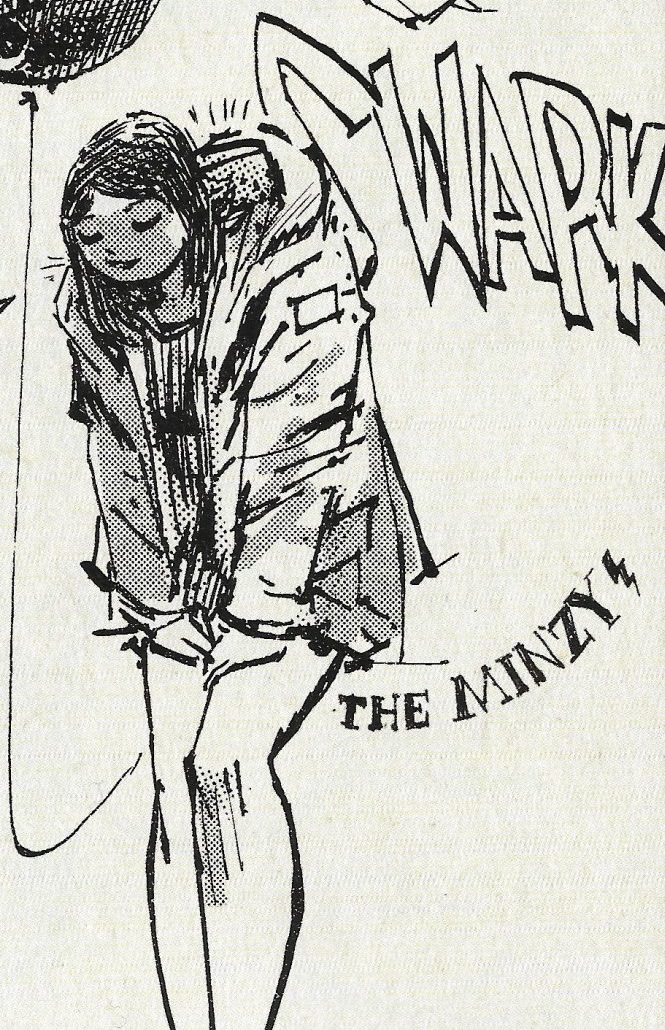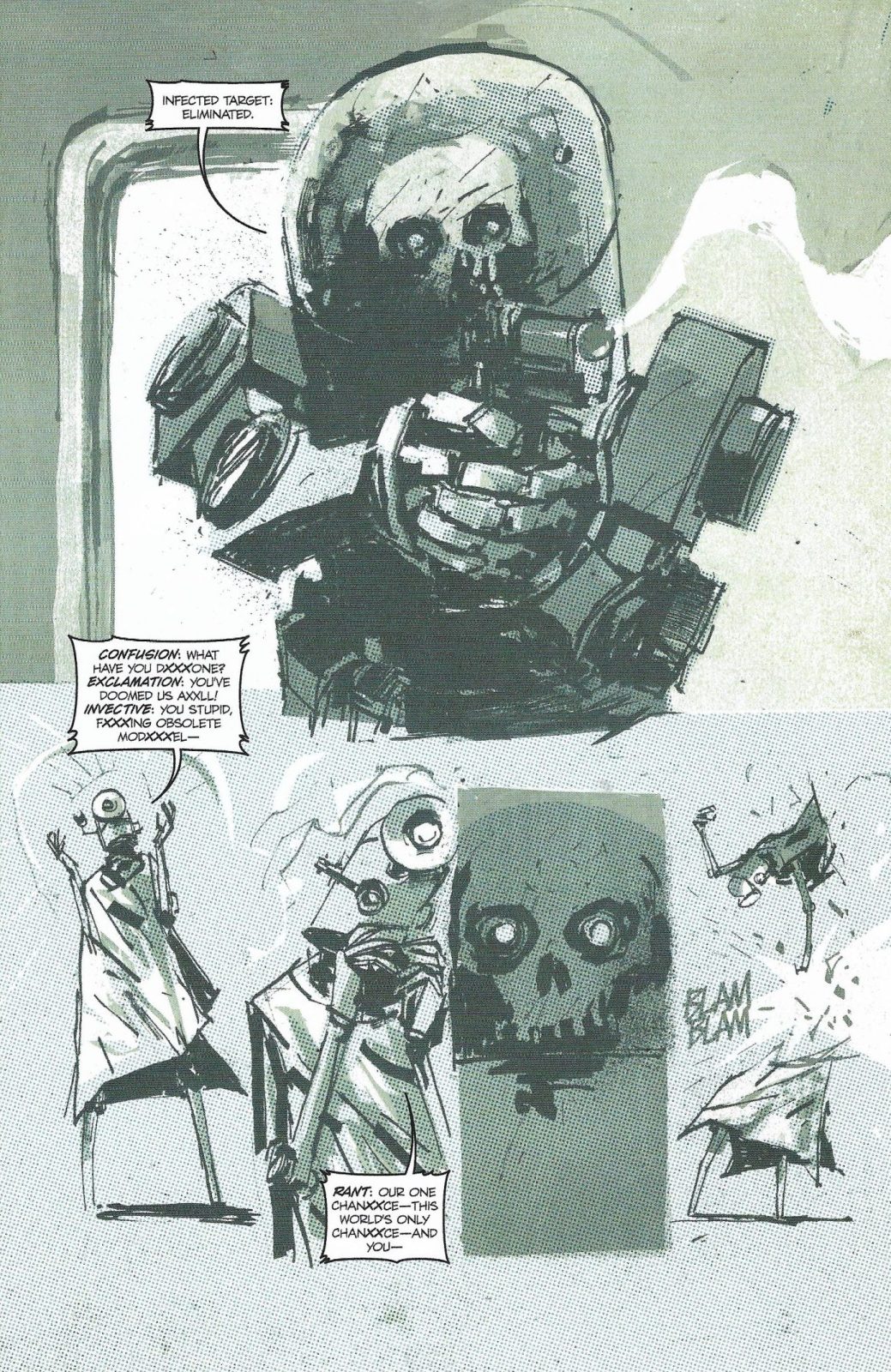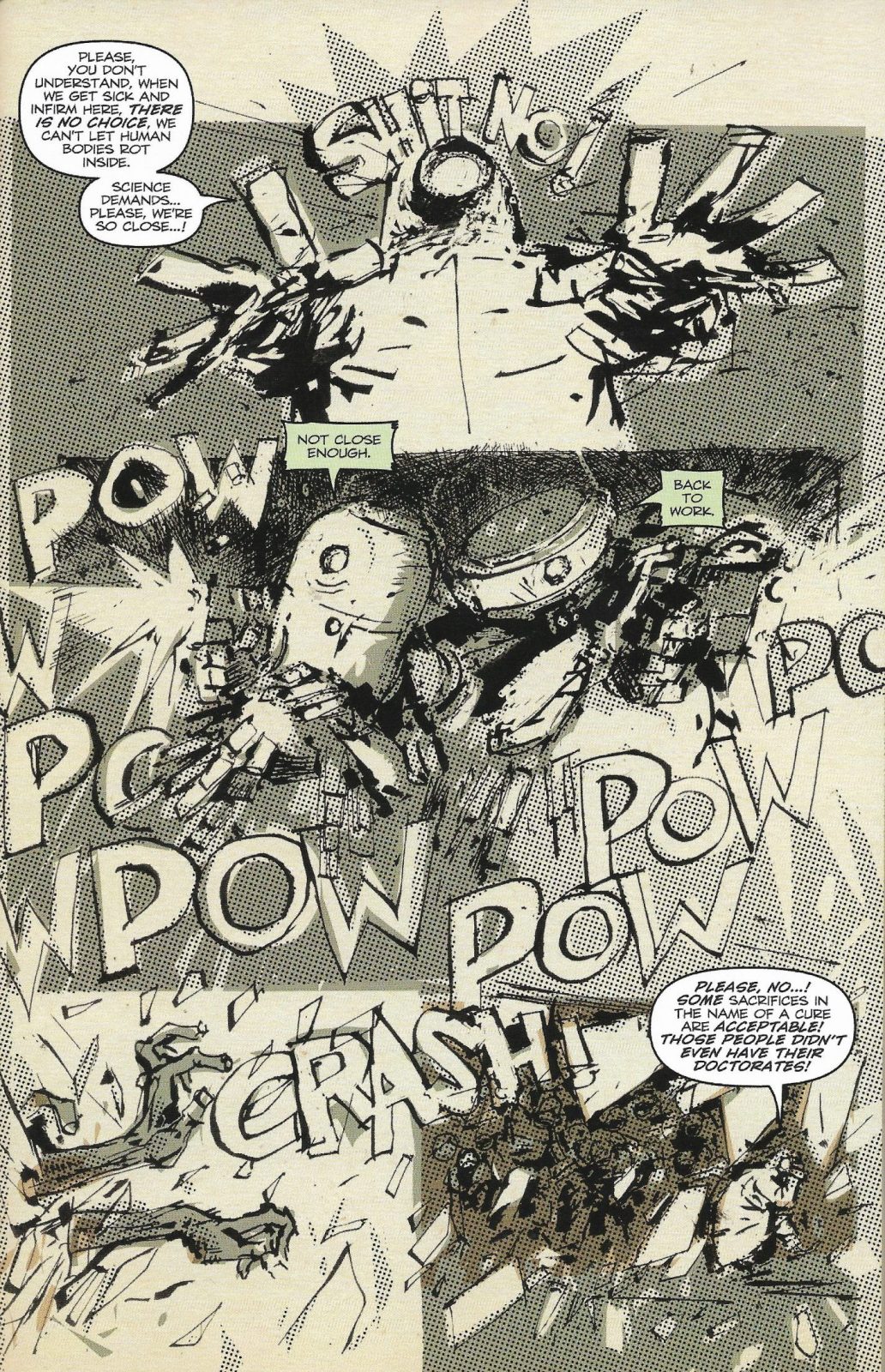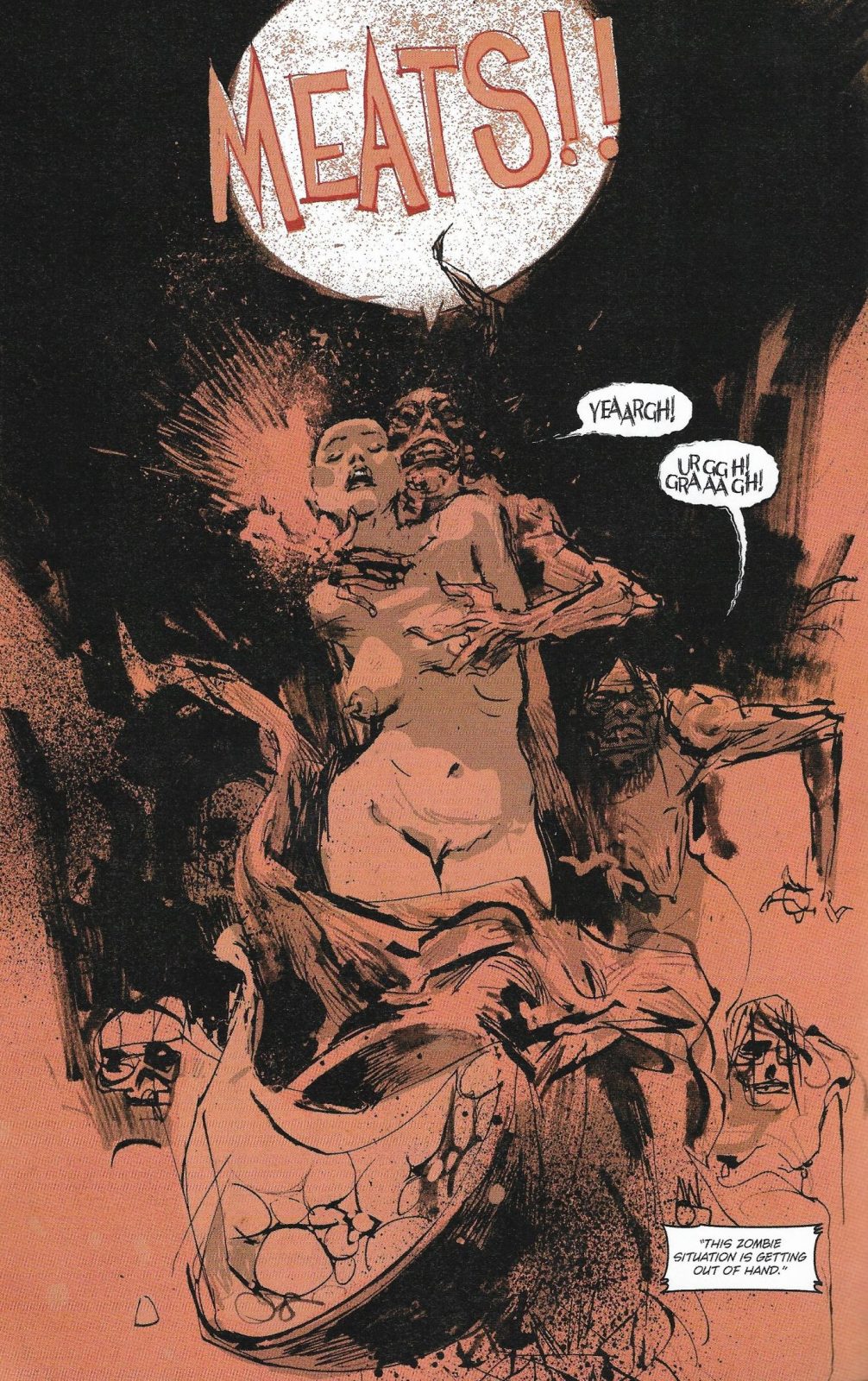
“I’m... not even sure if I’ve ever even named any of them. I was hoping you’d know.”
“Never mattered to me,” Wood said. “It only matters how they look.”
Ryall smiled. “It never mattered to me, either.”
They joined arms. “Come on then,” he said to Wood. “We’ve got more beautiful brainless comics to make.”
And so they did.
-From the "Secret History of ZVR", a text supplement to ZVRC #4
* * *
The first Zombies vs Robots material saw print in 2006 - I would have sworn up and down it came out a little earlier, but nope. This was three years after Automatic Kafka—Ashley Wood’s and Joe Casey’s epochal, forgotten masterpiece—had been offered up by DC/WildStorm to die of exposure in the bear market of the second first Bush administration. The industry was doing a little better by the time Wood and Chris Ryall launched Zombies vs Robots (hereafter ZVR) at IDW. Little matter, it was past time for Wood to ever give a shit about placating the market, and a strong argument could be made that he never really did.
ZVR is a project where Wood gets to draw exactly what he wants how he wants. Worth pointing out, Wood doesn’t do that many new comics anymore. Never did a big Batman book, a strange elision if you think about it (he’s done a few covers over the years, enough to whet the whistle). I realize it may seem sort of “out of character” for The Comics Journal to complain that an artist as talented as Ashley Wood never did Batman, but... c’mon. We’re all friends here. You know it’d be good. However, he probably has a lot more fun working in industries that appreciate his talent, and wouldn’t you? He’s filled a career to date doing lots of cool stuff outside of comics. He doesn’t need us. We kind of suck.

He was clearly superlative from the very beginning. Wood’s early US work found him in the mold of early Jae Lee, with a pinch of Bisley. Nor was Bachalo’s influence completely forgotten. It’s “far out” in a way that recalls the imperial period of Bill Sienkiewicz - unpredictable but nevertheless an extraordinarily commercial style, it must be said. There’s always a market for “far out” stuff in mainstream comics, a sustained tendency perhaps due solely to The Sink’s improbable dominance over 1980s newsstands.

But the way that Wood really distinguished himself to my eye was in his steadfast refusal to ever settle down and become “just” another Sienkiewicz clone. The facts on the ground are clear, if you can learn to draw even just a little bit like The Sink you’re probably only stopping in those precincts a minute. It was a phase. By the early '00s, after a stint with Todd McFarlane, Wood was growing into a looser, very cartoony style - cartoony with a capital C, often a derogatory adjective but not here and not today. There’s a raw and unfettered vibe to the mature line at which Wood arrives in ZBR. Kurtzmanesque at times. Almost as if he were actually freehanding with a brush directly to the page. But we know better, right lads?
* * *
ZVRC ("Zombies vs Robots Classics") is a four-issue Image miniseries reprinting the various ZVR series under one title. Each issue is overstuffed by any measure; issues #2 & 3 are nearly 80 pages, reprinting the expected odds & ends and pin-ups and such. Wood has some paintings back there and you can see for yourself how physical an artist he is from the thickness of the impasto on his canvases. It reads as loose as any of his pen & ink work, and as funny.
The funny is important. That’s what sets ZVR apart, while also perhaps limiting its reach: it doesn’t take a single aspect of its premise seriously. There are few nods to zombie plague conventions. Humanity perishes in a zombie plague because scientists did something very bad, I think. It’s really not important. What’s important is understanding that humanity is more or less out of the picture by the time the main robot conflicts shake out. Later, Amazons show up to cross swords - the famous warrior women of myth and legend, trailing the Minotaur. Because sure, why not? (Did Wood ever really need a reason to draw leggy dames? No, not a reason - a rationale.) The robots were designed to protect humanity by destroying zombies, but as it turns out in the course of the story they run out of people to save long before they run out of zombies to kill. Cue existential angst amongst the robots.
In the time since the ZVR stories were published The Walking Dead came and went as one of the dominant pop culture moods of the Obama era. We all got used to the idea that zombie stories were grimdark popular entertainment for a culture that was growing used to the idea of letting mass swaths of the body politic die. As a high concept, robots stumbling around the end of the world and having awkward conversations while mowing down endless hordes of zombies (and the occasional mythical beast) seems prescient to a media environment where self-aware comedy horror represents a mature market niche. Maybe it doesn’t all have to be about the fantasy of being given permission to murder your neighbors. It can also be about the comedy of funny robots being given permission to murder your neighbors.
There’s another name on these stories besides Wood. Chris Ryall was the first person to print my writing online, a fact I hasten to add by means of deflecting blame. He was also affiliated with IDW for a number of years, and it appears there may have been a bit of drama involved in our dynamic duo reclaiming the publishing rights to ZVR from their erstwhile employer. (Because, you know. This is comics. That’s how we as an industry roll. We kind of suck!) In any event, without having any insight into the process, these stories read like nothing so much as two friends shooting the shit and making each other laugh. Not a bad vibe at all. Considering just how glum and pedantic zombie stories can tend it’s a breath of fresh air. Most of the dialogue is laconic, practically terse in places, with the occasional bit of funny purple prose hiding under the slip.
Ryall has a light touch as a writer, knows when to stay out of the way of the 400lb gorilla. It’s a good partnership, especially to judge by the fact that the two have set up shop with a new subimprint at Image, Syzygy. I first became aware of this development when I picked up a book by Wood and writer T.P. Louise called 7174 Presents Haunted Universus, unlike anything else I’ve read this year, filled with creepy horror and explicit sex. My store put it on the top shelf, with the Vampirella and Zenescope books, in a Mylar bag no less. They usually only do that for expensive variants, so I asked if the book had a price hike - no, the book was just a little bit more explicit than they expected. Sure enough, there’s a full-page spread of a holy hermaphrodite with Trafalgar Square hanging out, so I can see why they put it on the top shelf.
Syzygy as an imprint seems split between fairly commercial offerings from outside creators and whatever the fuck Ashley Wood feels like doing at any given time. That’s... actually a really solid remit. You could do worse. Recently they announced a book called All Against All, high concept “Alien but the human is the xenomorph.” Strong elevator pitch, promo art looks pretty hot. I don’t really understand the 7174 material yet but it seems like a project that’s might add up to something bigger down the road, situated somewhere in the neighborhood of Al Columbia and Moore’s & Campbell’s spoken word adaptations, The Birth Caul and Snakes & Ladders. (Possibly my favorite works from either creator, incidentally.) Your store probably didn’t order enough 7174 for the shelf—owing to it being a lyrical psychosexual metaphysical odyssey and all—but maybe if you ask nicely they still have some at the distributor.
It’s a far cry in some respects from 7174 to the ZVR material, very different moods and collaborators united only by the common thread of being vehicles for Wood’s immense talent. As strange as it may seem apparently they were going to make a ZVR movie and it being stuck in development hell for years was a major thorn in the sides of its creators. It’s strange to think of the book as just another IP to be mined, with characters and sagas and such, when the story’s appeal appears to me more or less synonymous with appreciating Wood’s gorgeous art. Ryall even made some ZVR comics without Wood, as improbable as it seems, though you won’t find any of that material here.
 Open up the last issue of the series to “A Small Tale”. Behold the first spread, a lush treeline with a small robot trailing a leash behind. I invite you to linger over every leaf. In a word it is stunning, Alex Toth crying tears of blood stunning. The story is the farthest ahead in the loose ZVR timeline, and people have returned - just a few poking around the edges in the ruins of the world that died in the war. Things have settled down - probably? As heavy as that sounds this is actually an endearingly whimsical story, split between wandering the renewed landscape and meeting a woman named The Minzy. (Would you believe me if I said The Minzy has a killer set of gams? I know, quelle surprise!) Her and a human child and a small robot go looking for someone they can’t find and run into zombies in some capacity. I’m going to be honest with you chief: I’m not really sure what happens at the end of this story. That is sometimes the price you pay with Wood. It is worth it.
Open up the last issue of the series to “A Small Tale”. Behold the first spread, a lush treeline with a small robot trailing a leash behind. I invite you to linger over every leaf. In a word it is stunning, Alex Toth crying tears of blood stunning. The story is the farthest ahead in the loose ZVR timeline, and people have returned - just a few poking around the edges in the ruins of the world that died in the war. Things have settled down - probably? As heavy as that sounds this is actually an endearingly whimsical story, split between wandering the renewed landscape and meeting a woman named The Minzy. (Would you believe me if I said The Minzy has a killer set of gams? I know, quelle surprise!) Her and a human child and a small robot go looking for someone they can’t find and run into zombies in some capacity. I’m going to be honest with you chief: I’m not really sure what happens at the end of this story. That is sometimes the price you pay with Wood. It is worth it.
Why are you reading this series? ZVR never had to make sense. It’s already one of the best comics of its era, “making sense” would just be gilding the lily. Now, do you care about zombie stories making sense, or do you want to see Ashley Wood draw foliage and women’s legs? Because I’ll tell you what I want.












